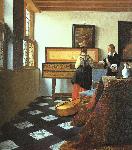Learn About Jan Vermeer in Art History, View His Art and Famous Paintings

Jan Vermeer, "Woman and Two Men", 1659-60
Jan Vermeer, 1632-1675, another of the Netherlands’s famous artists in art history, was born in Delft and remained in Delft. Vermeer painted only a small number of paintings, and is the reason there aren't many paintings in existence today. The subject matter of almost all his famous paintings is middle class, people going about simple everyday routine tasks with very little interaction.
In 1660, Vermeer painted his famous painting "The Cook".
 Instead of painting a renaissance religious art scene or a Caravaggesque religious setting with peasant figures, he paints a middle class woman doing the boring but necessary chores of everyday of life. Painting this subject matter Vermeer elevates routine daily tasks of life to high status religious art paintings. The scene is mellowed using soft, calm, gradated light.
Instead of painting a renaissance religious art scene or a Caravaggesque religious setting with peasant figures, he paints a middle class woman doing the boring but necessary chores of everyday of life. Painting this subject matter Vermeer elevates routine daily tasks of life to high status religious art paintings. The scene is mellowed using soft, calm, gradated light.
Jan Vermeer’s setting is so quiet and inactive that it almost becomes a still life. The linear edges are soft, the walls and tablecloth are neutral color, and somewhat dull.
The art comes to life only with the softly muted, rich primary colors of the cooks clothing that creates a high color contrast with the brightest part of the right wall. The paintings impact is an intense even atmosphere. Where harsh light creates intensity against a dark silhouetted figure in Rembrandts "Blinding of Samson", color contrast does the same thing in a calm more quiet way in Vermeer's painting.
There is an ideal quality in Jan Vermeer’s “The Cook” as the light sources are different throughout, exampled by the basket near the window, the light on the upper part of the cook's dress, the light on her forearm and the light on the blue cloth draped over the table.
Also idealistic is the incongruity of the perspective points in the painting. The linear line of the table lines up with the orthogonal line of the window sash but doesn't line up with the sill below it. If the sill and sash lines were carried out beyond the painting, they would separate and not be part of the same functioning unit.
Two orthogonal lines of the lattice work in the window line up with the box on the floor, but do not line with the other horizontal lattice pieces in the same window. These incongruities are easily overlooked with the overshadowing atmospheric quality of the art.
"The Letter", painted by Jan Vermeer in 1666, engages the viewer as a letter carrier in the painting.
 The viewer has just delivered a letter to a young woman and is now standing outside the door waiting for a response.
The viewer has just delivered a letter to a young woman and is now standing outside the door waiting for a response.
The setting is decorative. Every space is filled with a linear art pattern, or textural quality. The combination of the strong highlighted figures with the white squares of the floor, the sun on the back wall, together with the many decorated objects around the room gives the painting a new modern look not seen before in the art of the seventeenth century.
Jan Vermeer is the best known of the seventeenth century “Dutch Masters” in art history. In some of his famous paintings he used a pinhole predecessor of the modern camera to project an image on the wall to aid the visual construction of his artwork. Other famous artists of the Baroque period are Rubens, Rembrandt and Claude Lorraine.
To view the entire gallery of Jan Vermeer paintings, click here.
Click on the graphics below to increase graphic sizes. At the same you time can also view an opportunity to purchase a poster or painting reproduction.
















|